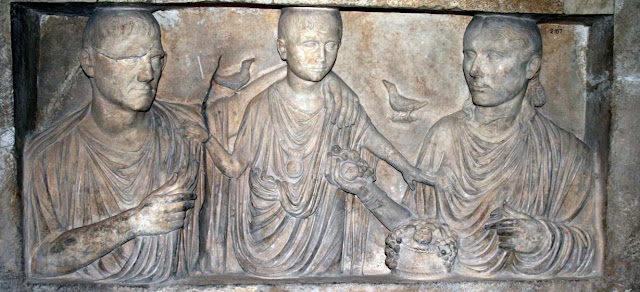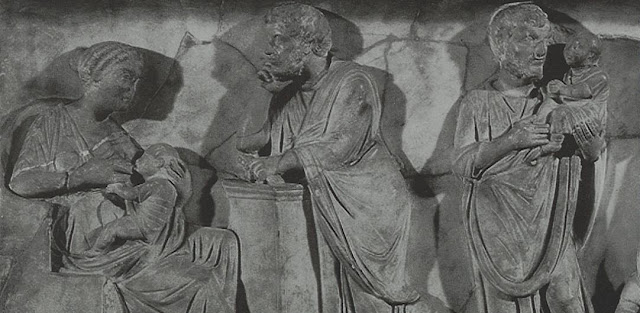Slavery is an institution common to all the races, whether civilised or barbarian, of the ancient world and it was certainly recognised from the earliest times at Rome. Its chief source was then, as at all times, capture in war, and there is no doubt that the rule which makes a child the slave of the person who owns his mother goes back to remote antiquity. Such minor modifications of this rule as exist in classical times are due to a late principle of favouring liberty wherever possible and were no doubt absent from the earliest law. The slave was always at Rome, so far as the law was concerned, a piece of property and any limitations on the power of the master to do as he liked with him were, at the times of which we are speaking, still in the distant future. In two respects only can we say that the civil law recognised the humanity of the slave, (a) in the possibility that the master might acquire rights through him and (b) in his capacity to become a free man, incapable of being owned, on manumission.

- Slavery at the time of the XII Tables
The civil law rule was that an act-in-the-law carried out by the slave enured to the benefit of the master, but could not place the master under any liability. A slave could thus, in the later law, make a stipulation for his master, because stipulation is a unilateral contract out of which duties arise only on the side of the promissor. If when A's slave says to B: "Will you pay my master 10?" and B replies "I will", B thereupon ows A 10. Not so with a sale, because a sale is bilateral, and the seller only acquires a right to the payment of the price in return for placing himself under the duty of delivering the thing sold. If therefore A's slave purports to sell A's property to B, B cannot force A to do anything, but A can enforce the contract against B if he likes, provided, of course, that he is willing to do his part. These examples belong to a period later than the
XII Tables, but there is no reason to doubt that the principle is ancient. A slave could, in classical times, receive a thing by mancipation on behalf of his master, and so presumably could he as soon as mancipation had become a mere conveyance, not necessitating the real payment of any price. In
iure cessio to a slave was however not possible because, as Gaius says, he could not claim anything as his own.
The only way in which a man's legal rights could be adversely affected by his slave's act was by delict on the part of the slave, for if the slave committed a delict the master must either pay damages, or lose his slave. But this cannot be regarded as an admission of the slave's humanity because very similar rules applied in the case of damage inflicted by animals.
- Manumission at the time of the XII Tables
The developed civil law knew of three methods of manumission, all of which had the effect, provided they were correctly carried out, of making the slave not only free but a citizen.
+ Censu
This consisted in the enrolment of the slave with his master's consent in the list of citizens drawn up at the
census. It was the slave who actually gave his name to the magistrate charged with the
census, but the authorisation of the master was of course necessary, and if it were not given the magistrate would refuse to accept the name, as, no doubt, he might also refuse if he himself considered the man unfit for citizenship.
+ Vindicta
A more common method was that which consisted in the use for the purpose of manumission of the form appropriate to an action in which liberty was claimed (
causa liberalis). It might, of course, happen that a person held as a slave wished to claim that he was really free. In such a case it was not open to him to bring the necessary action himself; he had to get some citizen to act as claimant (
adsertor libertatis) and the proceedings took the form (so long as the
legis actiones were in use) of a
legis actio sacramento. The parties came before the magistrate and the
adsertor, touching the man with the wand (
vindicta or
festuca), asserted his freedom; then the defendant also touched the man and asserted that he was his owner, and finally after further formalities, the matter was sent for trial by a
iudex in the ordinary way.
When a master wants to use this process for the purpose of freeing his slave, he gets some citizen (in fact one of the magistrate's lictors was commonly used) to act as
adsertor and make a claim that the man is free; then, instead of contesting the claim (as he would do if involved in a real
causa liberalis), he remains silent, and so admits the claim. He does, however, here too place his wand on the man, and it appears indeed that it is from this act of his rather than from that of the lictor that the proceeding takes its name. The process then ends with the declaration (
addictio) by the magistrate that the man is free.
Manumission
victicta is thus in form a collusive action, but it cannot, any more than
in iure cessio, be explained simply as such. The magistrate knowns the purpose of the transaction and can, if he disapproves, refuse his
addictio. Further, the effects are not the same as they would be in the case of an ordinary action, merely an effect between the parties; the man becomes free for all purposes. Also he becomes free only from the moment of manumission, whereas the decision of a
causa liberalis in favour of liberty would necessarily imply that the man had been free before the action was begun. He becomes, too, the freedman of his former master, whereas if he had been free all along he might not be a freedman at all but free born. Manumission
vindicta is in fact a form of
cessio in iure, and here too we have to deal with a hybrid institution, beginning perhaps as a sort of collusive action, but coming to be recognised as something quite different.
+ Testamento
Manumission by will was the most common of the three forms, for a man who dislikes parting with his property during his lifetime, may have no objection to being generous at the expense of his heirs. The gift of liberty must, like a legacy, be in authoritative words, the usual form being
Stichus liber esto or Stichum liberum esse iubeo; like a legacy, too, it is dependent on the validity of the will as a whole, and where the heir is an
extraneus takes effect only from the moment of his entry.
Of the relative antiquity of the three forms we can say little. Manumission by will certainly existed as early as the XII Tables, for we find a reference to conditional gifts of liberty, and a condition could not be attached to either of the other forms. Very probably the code did nothing more than confirm an existing institution.
Manumission
vindicta is said by Livy to have been used first to liberate a slave who had given information of a monarchist plot in the first year of the republic, and this would of course mean that it existed at the time of the XII Tables if any particular credence could be given to the story. For manumission
censu there is no evidence. It is sometimes said that both
vindicta and
censu being fictitious processes, in which there is a pretence that the slave is already free, must be older than
testamento which is a direct gift of liberty, the idea being that original Roman law knew of no manumission at all. But it is by no means agreed that
censu or even
vindicta have anything fictitious about them, and if they have not, even this argument falls to the ground, so that we are left without any information as to the relative age of the three forms.
There is also dispute about another, related, matter. Did the rule that manumission gave not only liberty but citizenship go back far into history, and did it apply to all three methods from their inception? Our information is scanty, but this, at least, can be said. All methods involved originally the co-operation of a public authority, that of the magistrate in
vindicta and
censu, that of the assembly in
testamento (at least if testamentary manumissions go back to the comitial will). This control ceased as the private will
per aes et libram developed, and as, with the increase in population, it became impossible for the magistrate to know anything about the people brought before him for manumission, but its existence in the early stages is significant. If is existed then, it is an argument in favour of the antiquity of the citizenship rule, for unless manumission made the slave a citizen, it is difficult to see why the state should have been so deeply interested.
----------
Source:
Historical introduction to the study of Roman law, H. F. Jolowicz, pages 135 - 138.






